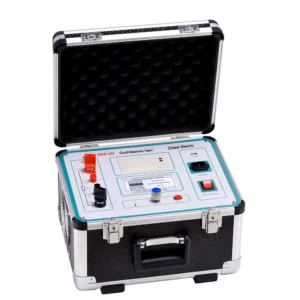What are the factors to consider when selecting an ground resistance tester?
When selecting a ground resistance tester, several factors should be considered to ensure it meets your specific requirements and provides accurate and reliable measurements.
Some of the key factors to consider include:
- Measurement Range: Choose a ground resistance tester with a measurement range suitable for the types of grounding systems you need to test. Ensure it can measure both low and high resistance values, covering the range typically encountered in your applications.
- Accuracy: Look for a tester with high accuracy to ensure precise measurement results. Consider the accuracy specifications provided by the manufacturer and ensure they meet your measurement requirements.
- Resolution: The resolution of the tester determines the smallest change in resistance that it can detect. Higher resolution allows for more detailed measurements, particularly for low resistance values.
- Test Frequency: Some ground resistance testers offer multiple test frequencies, such as 128 Hz, 256 Hz, or 1000 Hz. Different test frequencies may be suitable for different grounding systems and soil conditions. Choose a tester with selectable test frequencies or one that offers the appropriate frequency for your specific applications.
- Test Method: Ground resistance testers may use different test methods, such as the 3-wire method, 4-wire method, or clamp-on method. Consider which test method is most suitable for your applications in terms of accuracy, ground resistance tester convenience, and ease of use.
- Display: Look for a tester with a clear and easy-to-read display that provides real-time measurement readings. A backlight or large LCD screen can be beneficial for visibility in various lighting conditions.
- Data Logging and Storage: Some testers offer data logging capabilities, allowing you to store measurement results for later analysis and documentation. Consider whether this feature is important for your applications and look for testers with sufficient data storage capacity.
- Durability and Portability: Choose a tester that is durable and suitable for use in the environments where you’ll be conducting measurements. Consider factors such as ruggedness, water resistance, and portability for field use.
- Safety Features: Ensure the tester has built-in safety features to protect both the user and the equipment being tested. Features such as overvoltage protection, insulation resistance monitoring, and audible/visual alarms for unsafe conditions are important for safe operation.
- Calibration and Maintenance: Consider the calibration requirements and maintenance needs of the tester. Choose a tester from a reputable manufacturer that offers calibration services and provides adequate support for troubleshooting and maintenance.
By carefully considering these factors, you can select a ground resistance tester that meets your measurement needs, provides accurate results, and ensures safe and reliable operation in various applications.
